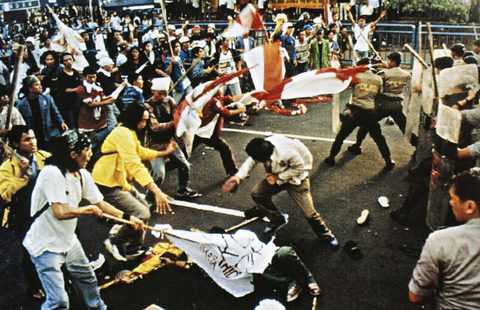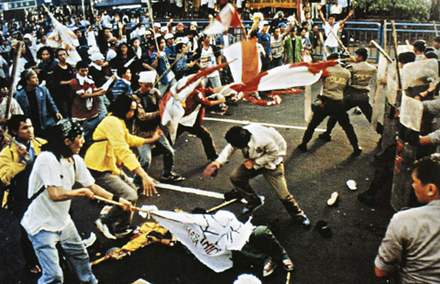In May 1998, Indonesia erupted in riots, with racially-motivated violence flaring up throughout the island nation, mainly in Medan and Northern Sumatra.
The riots, whose victims were mainly Chinese, helped usher in the resignation of President Suharto and the fall of the New Order regime.
Now another Indonesian presidential hopeful, Prabowo Subianto, could feel the full force of their legacy.
Discussion about Prabowo’s possible involvement in the riots are almost always associated with technical issues such as the chronological order of events, places, and the characteristics and patterns of actions of the perpetrators in the field; they read like a ‘who-dunnit’ mystery that can only be solved through ‘physical evidence’.
Certainly there are meetings between Prabowo and others, as well as doubts about his whereabouts at the time, which possibly link him to the events of May 1998 – even if he wasn’t actually at the centre of the violence. And according to a fact finding team, Prabowo Subianto was a key figure in military involvement with rioters in Jakarta.
However, the shortcomings of all reports and investigations into Prabowo’s involvement in the tragedy is that they ignore how Prabowo can be ideologically attributed to the anti-Chinese riots.
It is rarely remembered that on January 26, 1998, Prabowo invited a group of Muslim intellectuals and clerics to a fast-breaking at Kopassus headquarters. While Prabowo gave a speech about foreign threats to the stability of nation, his staff distributed books containing data on the economic dominance of Chinese-Indonesians in Indonesia to the audience of around 5,000.
According to Prabowo, the monetary crisis which hit Indonesia at the time was the result of an international conspiracy related to Chinese-Indonesian businessman. In particular, he directed his accusation towards Sofyan Wanandi (Liem Bian Koen) and his brother, Yusuf Wanandi (Liem Bian Kie), along with their prominent think-tank CSIS. Around the same time as he was giving this speech to intellectuals and clerics, a mob surrounded the CSIS offices in Jakarta for two days (26 to 27 January 1998).
In his political memoir Shades of Grey, Jusuf Wanandi writes about how Prabowo tried to intimidate CSIS by sending hundreds of demonstrators to its headquarters. Wanandi also notes that Prabowo blamed Chinese-Indonesian businessmen for the financial crisis sweeping across the country and the region. In particular, Prabowo accused Chinese-Indonesian businessmen of economic sabotage as a means of bringing down Soeharto.
Before the financial crisis of 1997, Hashim Djojohadikusomo was the owner of several banks, including Bank Pelita, Bank Industri, Bank Papan Sejahtera, and Bank Niaga. The monetary crisis in 1997 led to many bank depositors to move their money to Singapore and Hong Kong. The banks owned by Hashim were highly affected by this. This economic blow to the Djojohadikusomo family was later interpreted by Prabowo as an international conspiracy involving Chinese-Indonesians as accomplices.
As a response to a solicitation by Prabowo, on February 8, 1998 a meeting was held at the Al-Azhar mosque. Among others, it was attended by Ahmad Soemargono (KISDI) and Kiai Haji Cholil (MUI and DDII). Both held similar views to Prabowo’s. Besides participating in condemning Sofyan Wanandi and CSIS, a speaker at the meeting also accused Chinese-Indonesian and non-Muslim groups for being involved in a conspiracy to destroy Indonesia. Meanwhile another speaker stated that the Armed Forces and Islam must work together to face this threat.
In the “Buku Putih Prabowo” this is described as follows:
Prabowo fosters relationships with the Islamic leaders which feel as victims of military injustice influenced by the Christian and government, as well as isolated in a Chinese-dominated economy. Among them are: Amien Rais, a professor from Yogyakarta which in his attacks against Christian powers and Chinese’s capital turned into open criticism against Soeharto.
However Prabowo himself has denied that he is anti-Chinese view. While saying that an economy dominated by a Chinese-Indonesian minority is not healthy, he stressed that: “The Chinese businessmen thought that I want to displace them. On the contrary, my model is the New Economic Policy (NEP) of Malaysia.”
The NEP is a Malaysian economic model that is applied to create equity between Bumiputra (read: Malay) and other ethnic (predominantly Chinese-Malaysians) and foreign capital in Malaysia. The system was implemented in Malaysia in 1969 after the outbreak of deadly race riots.
According to some, the riots broke due to the high poverty among Malays in Malaysia at the time. The Malaysian government at the time thus instituted the NEP in order to redistribute wealth from the Chinese-Malaysian minority to the Bumiputra majority.
Is it possible that Prabowo felt that to apply the same economic model in Indonesia likewise required a race-riot to serve as a pretext for an “Indonesian NEP”? Of course, the riots of May 1998 failed to achieve this.
Prabowo denied that he would target Chinese-Indonesians solely for implementing the NEP: “Let’s say that you do not believe that I have a sense of humanity… If we exterminate the Chinese people, our economy will also perish. Same thing to commit suicide …”
Of course, just like the 1969 riots in Malaysia that led to the implementation of the NEP as a ‘solution’, the May 1998 riots in Indonesia were also not designed to ‘exterminate’ Chinese-Indonesians, but rather to act as a punishment for dominating the economy. At the same time, race-riots would serve as a pretext for implementing the NEP which would benefit ‘Pribumi’ businessmen, like Hashim and the family of Djojohadikusomo.
Taking into account all of the above, we can trace the link between Prabowo’s anti-Chinese-Indonesian attitude, and the political-economic interests of his family. It completes the missing part of the riot puzzle.
Many have long questioned why the riots in May 1998 turned into racial violence against Indonesian -Chinese, when the student-led reform movement itself had aspired to liberate all segments of society that were the victims of New Order oppression.
But the student-led reform movement was a social movement that aimed to dismantle the authoritarianism of the New Order, including repression of ethnic Chinese. On the other hand, the anti-riot May 1998-China was part of an attempt to covertly condemn Chinese-Indonesians as accomplices of an international conspiracy. In short, the student movement and the race-riots were two entirely different events.
In all of this it remains difficult to find evidence of direct involvement by Prabowo in the May 1998 anti-Chinese riot. But based on the analysis above, at least we may conclude that Prabowo had an interest in portraying Indonesian Chinese as a scapegoat for the financial crisis of 1997.
With this history in mind, it is striking that in recent weeks, Prabowo has once again aligned himself with the same Islamic forces, such as the FPI, and Amien Rais.
Tonny is a lecturer who lives in Surabaya, East Java, Indonesia.
 Facebook
Facebook  Twitter
Twitter  Soundcloud
Soundcloud  Youtube
Youtube  Rss
Rss 
